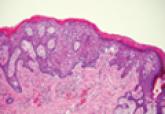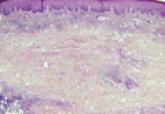Dermpath Diagnosis

Rosai-Dorfman Disease
Rosai-Dorfman disease, also known as sinus histiocytosis with massive lymphade-nopathy, is a rare benign histioproliferative disorder of unknown...
Eamonn Emerson Maher, BS; Claudia I. Vidal, MD, PhD
Mr. Maher is from the Joan C. Edwards School of Medicine, Marshall University, Huntington, West Virginia. Dr. Vidal is from the Department
of Dermatology, Saint Louis University, Missouri.
The authors report no conflict of interest.
Correspondence: Claudia I. Vidal, MD, PhD, Department of Dermatology, Saint Louis University, 4th Floor, Room 402, 1755 S Grand Blvd,
St Louis, MO 63104 (cvidal1@slu.edu).

Trichilemmomas are benign follicular neoplasms that exhibit differentiation toward the outer root sheath of the pilosebaceous follicular epithelium. Trichilemmomas clinically present as individual or multiple, slowly growing, verrucous papules appearing most commonly on the face or neck. The lesions may coalesce to form small plaques. Although trichilemmomas typically are isolated, patients with multiple trichilemmomas require a cancer screening workup due to their association with Cowden disease, which results from a mutation in the phosphatase and tensin homolog tumor suppressor gene, PTEN. An easy way to remember the association between trichilemmomas and Cowden disease is to alter the spelling to “trichile-moo-moo,” using the “moo moo” sound of an animal cow as a clue linking the tumor to Cowden disease.
The differential diagnosis for trichilemmoma includes inverted follicular keratosis, squamous cell carcinoma in situ, verruca vulgaris, and warty dyskeratoma.
Trichilemmomas are benign follicular neoplasms that exhibit differentiation toward the outer root sheath of the pilosebaceous follicular epithelium.1 Trichilemmomas clinically present as individual or multiple, slowly growing, verrucous papules appearing most commonly on the face or neck. The lesions may coalesce to form small plaques. Although trichilemmomas typically are isolated, patients with multiple trichilemmomas require a cancer screening workup due to their association with Cowden disease, which results from a mutation in the phosphatase and tensin homolog tumor suppressor gene, PTEN.2 An easy way to remember the association between trichilemmomas and Cowden disease is to alter the spelling to “trichile-moo-moo,” using the “moo moo” sound of an animal cow as a clue linking the tumor to Cowden disease.
Histologically, trichilemmomas exhibit a lobular epidermal downgrowth into the dermis (Figure 1). The surface of the lesion may be hyperkeratotic and somewhat papillomatous. Cells toward the center of the lobule are pale staining, periodic acid–Schiff positive, and diastase labile due to high levels of intracellular glycogen (Figure 2). Cells toward the periphery of the lobule usually appear basophilic with a palisading arrangement of the peripheral cells. The entire lobule is enclosed within an eosinophilic basement membrane that stains positively with periodic acid–Schiff (Figure 2).1 Consistent with the tumor’s differentiation toward the outer root sheath of the hair follicle, trichilemmomas have been reported to express CD34 focally or diffusely.3
| Figure 1. A lobular trichilemmoma composed of aggregates of epithelial cells extending from the epidermis into the dermis. The cells of the tumor are composed of squamoid cells showing variable glycogen vacuolation (pale-staining cytoplasm) and there is a surrounding prominent basement membrane (arrow)(H&E, original magnification ×40). | Figure 2. High-power magnification showing the pale-staining cells comprising a trichilemmoma (asterisk) as well as peripheral palisading of the cells at the periphery of the lesion and a thickened surrounding membrane (arrow)(H&E, original magnification ×200). |
Similar to trichilemmoma, inverted follicular keratosis (IFK) commonly presents as a solitary asymptomatic papule on the face. Inverted follicular keratosis is a somewhat controversial entity, with some authorities arguing IFK is a variant of verruca vulgaris or seborrheic keratosis. Histologically, IFKs can be differentiated by the presence of squamous eddies (concentric layers of squamous cells in a whorled pattern), which are diagnostic, and central longitudinal crypts that contain keratin and are lined by squamous epithelium.4 Basaloid cells can be seen at the periphery of the tumors; however, IFKs lack an eosinophilic basement membrane surrounding the tumor (Figure 3).
Squamous cell carcinoma in situ classically appears as an erythematous hyperkeratotic papule or plaque on sun-exposed sites that can become crusted or ulcerated. Microscopically, squamous cell carcinoma in situ displays full-thickness disorderly maturation of keratinocytes. The keratinocytes exhibit nuclear pleomorphism. Atypical mitotic figures and dyskeratotic keratinocytes also can be seen throughout the full thickness of the epidermis (Figure 4).5
Verruca vulgaris (Figure 5) histologically demonstrates hyperkeratosis with tiers of parakeratosis, digitated epidermal hyperplasia, and dilated tortuous capillaries within the dermal papillae. At the edges of the lesion there often is inward turning of elongated rete ridges,6,7 which can be thought of as the rete reaching out for a hug of sorts to spread the human papillomavirus infection. Although the surface of a trichilemmoma can bear resemblance to a verruca vulgaris, the remainder of the histologic features can be used to help differentiate these tumors. Additionally, there has been no evidence suggestive of a viral etiology for trichilemmomas.8
 Figure 5. Compact hyperorthokeratosis with tiers of parakeratosis (arrow), digitated epidermal hyperplasia, hypergranulosis, vacuolated granular layer cells, and small blood vessels extending into the tips of the dermal papillae (asterisk) in the setting of a verruca vulgaris (H&E, original magnification ×100).
Figure 5. Compact hyperorthokeratosis with tiers of parakeratosis (arrow), digitated epidermal hyperplasia, hypergranulosis, vacuolated granular layer cells, and small blood vessels extending into the tips of the dermal papillae (asterisk) in the setting of a verruca vulgaris (H&E, original magnification ×100).
Warty dyskeratoma features an umbilicated papule, usually on the face, head, or neck, that is associated with a follicular unit. The papule shows a cup-shaped, keratin-filled invagination; suprabasilar clefting; and acantholytic dyskeratotic cells, which are features that are not seen in trichilemmomas (Figure 6).9

Rosai-Dorfman disease, also known as sinus histiocytosis with massive lymphade-nopathy, is a rare benign histioproliferative disorder of unknown...

Extramammary Paget disease (EMPD) is an uncommon condition that usually presents in apocrine sweat gland–rich areas, most commonly the vulva...

Necrobiosis lipoidica diabeticorum (NLD) is a rare granulomatous skin manifestation that is strongly associated with diabetes mellitus....
